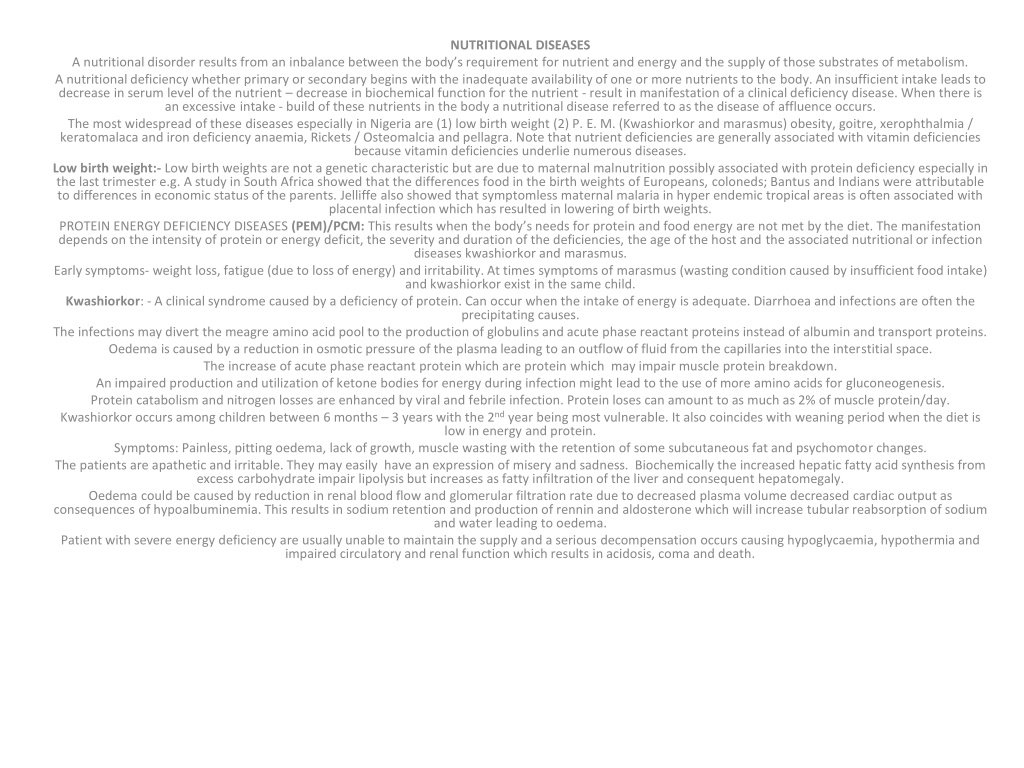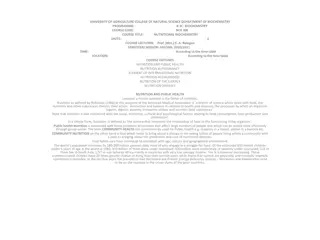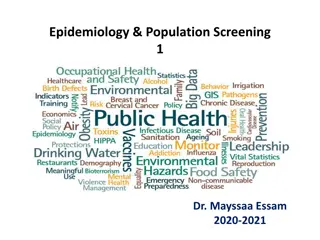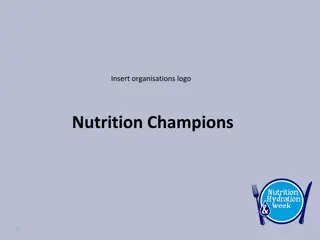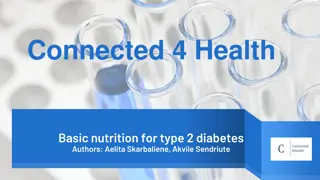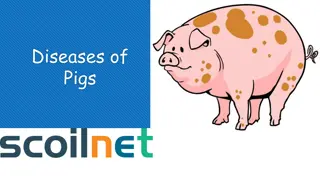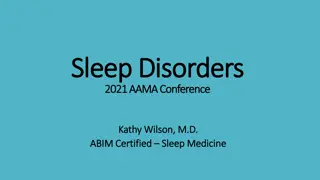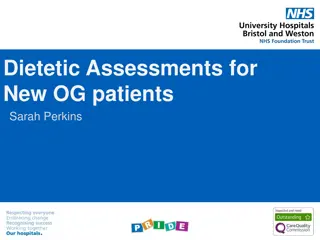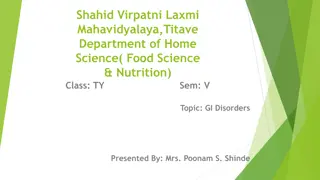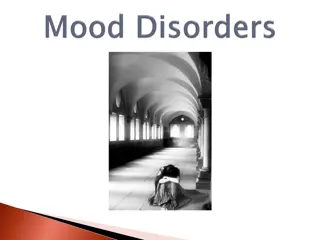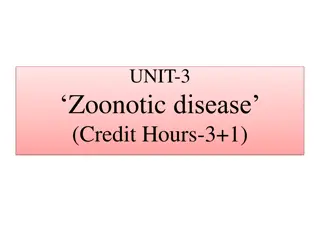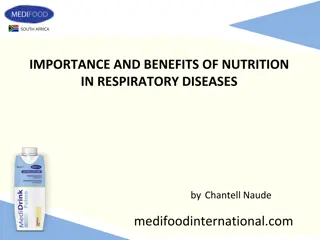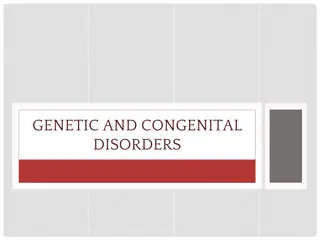Overview of Nutritional Diseases and Disorders
Nutritional diseases arise from imbalances between the body's nutrient and energy requirements and their supply. Nutritional deficiencies can lead to clinical diseases, while excessive intake can result in diseases of affluence. Common nutritional disorders include low birth weight, PEM, obesity, goiter, xerophthalmia, iron deficiency anemia, rickets, and pellagra. Low birth weight is often linked to maternal malnutrition, while PEM manifests as kwashiorkor and marasmus. Kwashiorkor is a protein deficiency syndrome, while marasmus is extreme undernutrition characterized by muscle wasting and mental development issues.
Download Presentation

Please find below an Image/Link to download the presentation.
The content on the website is provided AS IS for your information and personal use only. It may not be sold, licensed, or shared on other websites without obtaining consent from the author.If you encounter any issues during the download, it is possible that the publisher has removed the file from their server.
You are allowed to download the files provided on this website for personal or commercial use, subject to the condition that they are used lawfully. All files are the property of their respective owners.
The content on the website is provided AS IS for your information and personal use only. It may not be sold, licensed, or shared on other websites without obtaining consent from the author.
E N D
Presentation Transcript
NUTRITIONAL DISEASES A nutritional disorder results from an inbalance between the body s requirement for nutrient and energy and the supply of those substrates of metabolism. A nutritional deficiency whether primary or secondary begins with the inadequate availability of one or more nutrients to the body. An insufficient intake leads to decrease in serum level of the nutrient decrease in biochemical function for the nutrient - result in manifestation of a clinical deficiency disease. When there is an excessive intake - build of these nutrients in the body a nutritional disease referred to as the disease of affluence occurs. The most widespread of these diseases especially in Nigeria are (1) low birth weight (2) P. E. M. (Kwashiorkor and marasmus) obesity, goitre, xerophthalmia / keratomalaca and iron deficiency anaemia, Rickets / Osteomalcia and pellagra. Note that nutrient deficiencies are generally associated with vitamin deficiencies because vitamin deficiencies underlie numerous diseases. Low birth weight:- Low birth weights are not a genetic characteristic but are due to maternal malnutrition possibly associated with protein deficiency especially in the last trimester e.g. A study in South Africa showed that the differences food in the birth weights of Europeans, coloneds; Bantus and Indians were attributable to differences in economic status of the parents. Jelliffe also showed that symptomless maternal malaria in hyper endemic tropical areas is often associated with placental infection which has resulted in lowering of birth weights. PROTEIN ENERGY DEFICIENCY DISEASES (PEM)/PCM: This results when the body s needs for protein and food energy are not met by the diet. The manifestation depends on the intensity of protein or energy deficit, the severity and duration of the deficiencies, the age of the host and the associated nutritional or infection diseases kwashiorkor and marasmus. Early symptoms- weight loss, fatigue (due to loss of energy) and irritability. At times symptoms of marasmus (wasting condition caused by insufficient food intake) and kwashiorkor exist in the same child. Kwashiorkor: - A clinical syndrome caused by a deficiency of protein. Can occur when the intake of energy is adequate. Diarrhoea and infections are often the precipitating causes. The infections may divert the meagre amino acid pool to the production of globulins and acute phase reactant proteins instead of albumin and transport proteins. Oedema is caused by a reduction in osmotic pressure of the plasma leading to an outflow of fluid from the capillaries into the interstitial space. The increase of acute phase reactant protein which are protein which may impair muscle protein breakdown. An impaired production and utilization of ketone bodies for energy during infection might lead to the use of more amino acids for gluconeogenesis. Protein catabolism and nitrogen losses are enhanced by viral and febrile infection. Protein loses can amount to as much as 2% of muscle protein/day. Kwashiorkor occurs among children between 6 months 3 years with the 2ndyear being most vulnerable. It also coincides with weaning period when the diet is low in energy and protein. Symptoms: Painless, pitting oedema, lack of growth, muscle wasting with the retention of some subcutaneous fat and psychomotor changes. The patients are apathetic and irritable. They may easily have an expression of misery and sadness. Biochemically the increased hepatic fatty acid synthesis from excess carbohydrate impair lipolysisbut increases as fatty infiltration of the liver and consequent hepatomegaly. Oedema could be caused by reduction in renal blood flow and glomerular filtration rate due to decreased plasma volume decreased cardiac output as consequences of hypoalbuminemia. This results in sodium retention and production of rennin and aldosterone which will increase tubular reabsorption of sodium and water leading to oedema. Patient with severe energy deficiency are usually unable to maintain the supply and a serious decompensation occurs causing hypoglycaemia, hypothermia and impaired circulatory and renal function which results in acidosis, coma and death.
MARASMUS It is an extreme form of undernutrition due to lack of calories and proteins. It is characterised by generalized muscle wasting, absence of subcutaneous fat which gives the skin and bones appearance. The children have marked retardation in longitudinal growth, a lack of physical well being, abnormal behaviour and poor mental development. The hair is sparse, thin and without the normal sheen, the cheeks are sunken, because the disappearance of the bichat fat pads giving it the appearance of a monkey s or little old man s face. Marasmic condition develops slowly to allow better adaptation to energy inadequacy. A decreased energy intake is followed by a decreased energy expenditure which accounts for shorter periods of play and physical activity in children, and for longer rest periods and less physical work in adults. When the decrease in energy expenditure cannot compensate for inadequate intake body fat is mobilized at a faster rate than body mass resulting in weight loss. Where dietary proteins are of poor quality body proteins will not be synthesized, but body protein loses arise from skeletal muscle breakdown. Some visceral proteins are lost but this soon stabilizes until the non essential tissue proteins are depleted. The loss of visceral proteins now accelerates and death may occur. 75% of the free acids entering the body from dietary and tissue proteins are re utilized for protein synthesis, the remainder are broken down for other metabolic purposes. When dietary intake is decreased it causes a shift of albumin from extra vascular to the intra vascular pool, which leads to decrease in intra vascular oncotic pressure and outflow of water into the extra vascular space. This contributes to the development of oedema seen in kwashiorkor patient. Decreased fluid intake decrease insulin secretion and increase glucagon, epinephrine release and conticosteriod secretion. Severely underweight individuals are more likely to be ill and the recovery from illness is apt to take longer than with normal person. Nevertheless there is need for a gradual adjustment to normalcy as a premature introduction of a high calorie diet may be fatal to a severely marasmic patient. Diarrhoea which is the primary cause of death for under 5 children in the less developed countries occurs much more frequently among the marasmic children than among the well feed. OBESITY Obesity has been classified by the WHO as a disease of epidemic proportions for the poor countries. It is the most prevalent among the rich but in developed countries they look upon obesity as an undesirable development and a form of malnutrition. It is characterised by an excess accumulation of body fat, when an individual energy intake consistently exceeds its expenditure, weight gain occurs and this results in obesity. Actually human survival depends on body fat accumulation and maximizing energy utilization but in modern times when the supply of energy is constant throughout the year and the energy demand of daily activities has greatly decreased the adaptation has become a handicap. Garrow s method is used to classify obesity Body Mass Index (BMI) weight(Kg) / height(m2) (weight with minimal clothing with no shoes) BMI of between 25 and 29.9 = obesity grade 1 BMI of between 30 to 40 = obesity grade 2 BMI of over 40 = Normal adults have a BMI of 20 24.9. Since being overweight is not synonymous with being obesity it has become necessary to adopt the term desirable or ideal weight which is the weight that conforms to the longest life span. Another method for measuring obesity is the triceps skinfold thickness. Since more than half of the fat in the body is deposited under the skin and its % increases with age Seltzer and Stare proposed the figure of 23 mm and 30 mm for male and female as the minimum for defining obesity. In general, an adult obese person is one Who with the exception of the muscular athlete is 9kg or more above her desirable weight. Who weighs 15 20% or more above her desirable weight or weight attained at the age of 20 under normal nutritional considerations. Whose triceps skinfold thickness is 23 mm or more for men and 30mm or more for women at the age of 30 40 Whose BMI exceeds 25. Some studies have shown that there is increased mortality with increasing overweight with the higher mortality in men than in women. Also when obesity occurs at earlier ages 20- 40years it has a greater influence on cardiovascular disease than later-onset obesity. Since many of these deaths arise from cardiovascular disease and diabetes it would appear there are no single value of weight or fatness that is optimal for all. Hypertension occurs more often among the obese than among the non obese and the mortality rate of those who are obese hypertensives is higher than for those who are only obese or only hypertensive. Extremely obese individual develop respiratory difficulties which produces lethargy and somnolence (so we see that obesity has a high association with coronary heart disease, hypertension and maturity onset diabetes) obesity grade 3
CAUSES OF OBESITY Genetic: There are lot of investigations showing a high incidence of obesity among the parents of the obese. Withers provided circumstantial evidence to show that if neither parent is obese the risk of obesity may be less than 10% but if one of them is obese, the risk of fatness is 40%, if both parents 80%. The impact of family food and food consumption patterns which are taught by parents cannot also be overlooked. Newman and his co-workers discovered that theres a great difference between twins raised apart and twins raised together implicating environmental factor but identical twins however have tendency towards similar fatness or thinness implicating genetic component. Therefore, genetic factor is modified by environment and behavioural factor. The shape of the body is also important because a long thin person will have much more body surface than a short plump person of the same weight and the greater the body surface, the greater the heat loss. Body type or somatotypes: endomorphic (soft and roundish) has much fat storage capacity mesomorphic (bony and muscular) in between ectomorphic (lean, linear, fragile, thin or slender usually with long thin fingers) has low fat storage capacity Physical activity: The physical activity of an individual constitutes a measure of his lifestyle. Modern technology has ways of reducing this e.g. use of automobiles, television tap water etc. These conveniences have turned the population into a sedentary people. Where physical activity is not highly priced the genetic potential for obesity has greater opportunity to be expressed. Physiological factors: The food intake regulation centre is located in the hypothalamus of the brain. A short term regulation of the glucose sensitive receptors found in the ventomedial nucleus of the hypothalamus. When blood glucose is high the lateral nucleus (feeding centre) is shut off and activated again when glucose levels are low. The obese compulsive person seems to have lost the normal control mechanism and his appetite is controlled by external influences and finds it difficult to stop eating. Man and animals eat in response to hunger and appetite, when they are satisfied the person stops eating but the obese react to external cues related to food differently from that of the non obese. An over activity of the adrenal glands is also a cause. Psychological:- Many obese persons eat to derive certain types of satisfaction or to compensate for certain personality deficiencies e. g. The overweight gay who is not socially acceptable may appease his ego by indulging in unwise eating or someone who lacks affection, recognition may turn to food for solace. Sometimes this burdens on pathological state e.g. eating in the night syndrome with the patient suffering from insomnia and voracious appetite at night followed by a marked anorexia in the morning. Women tends to gain excess weight following puberty after their first pregnancy and during menopause but men tend to gain weight gradually after the age of 25. Actually the older we get the less energy we required due to change in body chemistry and as well as reduced activity changes i.e. BMR changes with age. Sociocultural influences: There s a belief that associates hearty eating with a change in fortune or occupational success but this comes at an age when caloric expenditure is decreased because of the modern conveniences and less physical activities. Generally in Nigeria urban dwellers are fatter than their village dwellers. Dietary factors Overfeeding in infancy may be a factor in the incidence of obesity later in life. Formula fed babies are usually fatter than breast fed babies. Infants who gain excessive weight during the 1stsix months of life have a greater likelihood of being obese later in childhood than do infants who gain normally. The lack of nutrition knowledge as relates especially to the caloric value, choice and amount of food is another cause of obesity. Cumulative effect of extra food eating beyond caloric needs e.g. a manager after eating tops it with beer and suya, or eating at so many engagements. Obesity in childhood: Fat cells adipocytes grow by increase in number and size and lose weight in the cell size not number. In infants growth occurs by increase in number and size, in adults it is increase in size. Obesity which results from an increase in fat cell number is called hyperplasic obesity. Obesity in early life is hyperplasic but in later life it is hypertrophic. Multiplication of adipocytes appears to take place during first 3years of life and adolescent period. People who become obese as children have a higher number of fat cells then those who become obese as adult. Prevention and treatment The best and most effective treatment is its prevention. Losing weight and keeping off the weight is extremely difficult especially for those who are 25% or more overweight. A gain of 2kg above one s ideal weight should be a signal to start curtailing energy intake. The mode of treatment varies from one individual to another. 1stconduct investigation to show whether it is due to endocrine problem (hypothyrodism) if it is accompanied by diabetes or other health problems - diet and dietary advice, psychological counselling, exercise and drugs. Dietary advice: Each patient should receive specific guideline must eat breakfast, avoid late dinners. Increase the amount of water, fruit and vegetable intake with less amount of food energy consumed. Lowering the total amount of fat especially animal fat will decrease the amount of energy and saturated fat consumed.Fish or chicken should be substituted for beef, decrease the amount of refined sugar and snacks. There is a liquid formula diet which can lead to a loss of weight within. 2-4 weeks but it is not sustainable they soon return to the conventional eating habit. Some proposed total fast especially type 11 obese but loose both fat and lean body mass which may not be easy to regain .In general a diet should permit the gradual loss of weight of no more than 0.9 kg/wk. The diet for a man should provide 1000 1500 KCal for man 1500 2000 KCal which supply the basal metabolism per day. Over eating in the evening which is more common in the obese should be avoided. Psychotherapy (behaviour modification): The believe that eating habits are learned behaviour so the focus is to change eating habit especially emotional and environmental (actions that can lead to overeating).
Exercise: If energy expenditure can be increased by incremental physical activity and energy intake is kept constant weight will drop but a significant amount of physical effort is required to expend a significant number of calories. Some drugs are given for weight control on a mixed theory of both appetite control and stimulation of the body to burn more fat. Surgical treatment: A short bowel is created to produce malabsorption of ingested calories. A small stomach is created so that the reduced reservoir for feed will prevent much caloric intake at anytime. Truncal vagotomy including suction lipectomy, jaws wiring can be done. Conclusion he must eat less than he would like to eat. Other Nutritional disease. Iron Deficiency Anaemia: - Anaemia is decrease in the total red cell mass due to fewer red blood cells or to smaller red blood cells which contain less hemoglobin. Nutritional Anaemia depends on nutritional factors involved in the causation e.g. iron, folic acid and vitamin B12. Iron deficiencies anaemia, folic acid deficiencies anaemic and vitamin B12Pernicious anaemia. Iron deficiency anaemia: The most common, it is characterized by hypochromia and microcytosis of the red blood cells. It results from inadequate diet, impaired absorption, blood loss or repeated pregnancies. The anaemia is prevalent in pregnancy because the requirement is so large and greater than dietary intake so must be supplemented. In the adult intestinal helmithiasis e.g. lookworm can cause anaemia also accident, surgery, menstruation or blood donation are the ways of losing blood and consequently iron deficiency (1ml of packed red cell = 1mg iron). Iron deficiency is also common among cereal (maize) eating population life. It is poor in iron. Non heme iron is the major source therefore enhancing its absorption will combat the deficiency. This is found in cereals and vegetables, meat, vitamin C improve its absorption. Iron pots also contribute to the supply. Iron excretion is limited since it depends on absorption, its being used and revised. It is stored in the lower spleen and bone marrow and used for erythropoiesis. Goitre This disease is more common in women than men and is often noticed at the onset of puberty, during pregnancy or at menopause. It is an iodine deficiency disorder. Iodine found in nature resides in the sea and ocean, hence its deficiency is more common in elevated regions. In Nigeria in hilly region food supplies comes from crops grown in iodine-deficient land. The thyroid gland contains about 70 or 80% of total body iodine used for synthesising thyroid hormones. It has to trap about 60 mcg of iodine/day to maintain an adequate supply of thyroxine. Where cassava is poorly processed, goitrogens such as thiocyanate may make iodine unavailable, where there is a congenital defect in the biosynthesis of MIT and DIT it may result in a congenital form of goitre and hypothyroidism. Congenital goitre does not occur in iodine deficient goitre. Where goitre is due to iodine deficiency, the term iodine deficiency disorder is used especially when 8-14 years olds have goitre. Food and Nutrition board recommends - 0 6 months (40 mcg), 6 month 1 year (50mcg), 1 10 years (70 120 mcg), > 11years (120 -150 mcg), pregnancy (175 200mcg). They are supplied by increased amount of sea foods, use of iodized salt and of cause injectable iodized oil. Xerophthalma / Keratomalacia: This is a deficiency disease of Vitamin A. Under normal circumstance the reception cells or cones of the retina required constant replenishment of the small amounts of vitamin A lost in the visual cycle during which a heme impulse is transmitted to the optical nerve and rhodopsin is regenerated. When there is a deficiency of vitamin A. It expresses itself in a progressive manner. First the vitamin A deficient person experiences a history of night blindness (nyctalopia which results from reduced concentration of rhodopsin in (low serum vitamin A) in the rod outer segment of the eye, followed by a sequence of abnormalities of increasing security in the conjunctiva and cornea termed xerophthalmia in which the protective secretion of the eye is lost with consequent keratinisation of the epithelial cells. The eye becomes dry, the cornea also becomes dry and loses its sensitivity. Severe irreversible change in the cornea which perforates with loss of aqueous humour is called keratomalacia. PEM and zinc deficiency may also lower the rhodopsin content of the eye also viral infection such as measles may also do so under the condition. Vitamin A deficiency also produces skin, changes of extra occular manifestations including perifollicular hyperkeratosis. Good sources are liver, whole eggs carrots, green leaf vegetable and palm oil. RICKETS/OSTEOMALACIA The biochemical and physiological consequences of inadequate vitamin D intake results in rickets in growing children and osteomalacia in adults. Rickets occurs when newly synthesised organic matrix osteoid fail to mineralize resulting in soft bones. Since the vitamin is essential for Calcium absorption it may also function in the prevention of osteoporosis later in life. Sources sun s irradiation of the skin, liver. Daily required of 200 400 1.U. Energy values of foods and energy expenditure by mammals Food eaten is used as fuel. End products of food oxidation are CO2, H2O and heat. CO2and H20 are eliminated in perspiration, heat is used to maintain body temperature. Part of the energy in food is used in muscular activity while the rest is stored as fat. Energy is obtained from carbohydrate, protein, fat and oil. Minerals and vitamin are necessary in the biochemical reaction involved in food oxidation. Unit: Calorie (C) unit of measurement is the amount of heat necessary to raise 1 kg of water through 1oC. The custom of expressing food values and food requirement in terms of calories is the usual practice. Method of Experimentation: 5 types of calorimeters are used for direct measurement of heat production. (1) Latent type e.g ice calorimeter of Lavoiser and Laplace (2) Bath calorimeter (fixed amount of water type) (3) The type that employs circulating air or water to remove heat e.g. respiration calorimeter (4) Emission type calorimeter (heat recording type) (5) Gradient or heat flow calorimeter. Most direct calorimeter remove the heat eliminated in a radiation and conduction by means of measured stream of cold water flowing through tubing in the chamber. The heat expended in evaporation of water by the skin and lungs of the subject (about 25% of the total) is determined by passing the air from the chamber through H2SO4absorbers and then measuing the and amount of H20 from this source. Normally the chamber is equiped with adiabatic devices which present the flow of heat through the walls in either direction. Some calorimeter are used without such regulation and are calibrated for heat loss by introducing a known amount of heat into the chamber and noting the amount recovered in the standard operating temperature of the chamber and room.
Calculation: Volume of H2O through absorbers = Average rise in temperature Water vapour produced Heat of vaporisation of water (18oC) Heat production 1860 Li = = = 0.515oC 1016gm 0.586 Cal/gm = (1860 x 0.515) + (1016 x 0.586) = 1553 Cal (b) Indirect calorimetry Respiratory exchange. It is prefered to direct method Better limited to short time observations. Two types of respiration chamber (1.) An airtight compartment large enough to allow freedom of movement of the subject and is supplied with either a closed or open circuit type of ventilation. (2.) Frequently employed method especially with human subjects is to connect respiratory passage with some sort of mask or breathing tube directly to the measuring appliances. These type of respiration chambers depend on whether the ventilation was to be of closed or open circuit type. Closed circuits: Consist of a glass bell jar, of sufficient size to accommodate a dog with tubes connecting it to an air sampling device, a manometer CO2 absorbers and flask of O2. O2 was admitted as regard to maintain atmospheric pressure as shown by the manometers the CO2beingremoved by KOH absorbers. Another method uses the spirometer, which is filled with a mixture of air and O2of unknown composition which falls gradually as the O2is consumed while the amount and rate are recorded on a kymograph. The exhaled air passes through a soda lime chamber which removes the CO2and excess moisture. Volume of O2used times 4.80 gives the calories produced. They are used to determine basal metabolisim. (2.) Haldane procedure:Determination of oxygen absorption as developed by haldane in 1892. Its convenient for small animals. (3.) Nitrogen C balance method The only analyses involved are N2, C and energy (determined with the bomb calorimeter). Feed intake and excreta over a period of time are used. (4.) Body balance method:It is limited to the determination of heat production over a long period of time and with small animals. It is accurate and better than other methods, no measurement of respiration. Terminologies in Nutritive evaluation Gross energy:Is the total heat produced when the food is burned in a bomb calorimeter. It is more and never lower than the energy available to the human body. Fat and carbohydrate are completely oxidized but protein only 78%. Digestible Energy:Is the energy of the food minus that of the feces called apparent digestibility. It is not a perfect measure of nutritive value since it includes UE, SDA and in case of ruminants methane. MetabolizableEnergy:Is the energy of food minus urine + faeces (and methane for ruminants). Net Energy: Is the net remainder after the expenses of utilization have been deducted from the feed energy (i.e. feces, urine, SDA, methane). Its an expression of the actual usefulness of a food for the purpose to be served. Factors affecting it includes capacity of the animal to eat. Only the amount of food eaten above the maintenance requirement is available for production. Net energy is a measure of what the food contains but of what it may accomplish e.g. milk (dairy cows) body tissue (stears). Total Digestible nutrients:A feed minus feces evaluation. The content between DE and TDN is one of the experimental determinations. To convert TDN to DE, multiply the weight of TDN in pounds by the factor 2000 to obtain its equivalent in calories. Basal metabolism: Is the heat production of a person in a postabsorptive state, lying awake and relaxed. SDA: The increase in heat production after the ingestion of food. SDA is about 6% of energy intake, attains a peak at about the third hour. Ingestion of protein produces a greater effect than carbohydrate or fat. Conclusion: The largest energy expenditure is the basal metabolism. Measurement of nutritive values The measurement of nutritive values of diets or of components of diets may be achieved in a variety of ways. The criterion of result may be gain in live weight, apparent digestibility, metabolizable energy or net energy of the feed, body gain in energy, body retention of specific nutrients effects on general health reproduction lactation length of life etc. The criterion to be used depends on condition to be met. Also the combination to be used must be determined by the investigation. Increase in body live weight is a common criterion. (a.) Group feeding:Consist of the amount of different food necessary to produce amount of useful product (gain in weight, milk, eggs etc). The method is used to project the overall food consumption of large groups as barracks.
(b.) the 2 rations to be compared, but one of them is fed ad libitum. Where good food intake occurs a nutritive different between the rations will become apparent in the superior growth of one subject of the pair it will be evident whether the poorer ration is unpalatable or an essential nutrient is lacking Ad libitum feeding If two rations of equal nutritive value but of unequal palatability are compared by feeding ad libitum, the results of the test are obvious, but the comparison will be obtained at a high level of intake with one ration and a low intake with the other. Length of experimental periods Short intervals of observation may contain errors of measurement. Longer periods are advised. Formulation of diets It is highly desirable to compare diets or ration of predetermined composition with respect to certain components. Basal metabolic Rate Fraction of the total energy metabolism that is needed to maintain the vital life processes of the body at rest. Paired feeding: Two subjects that are alike are chosen. Each is fed one of
